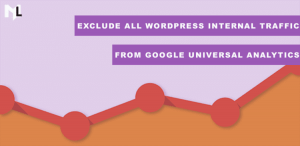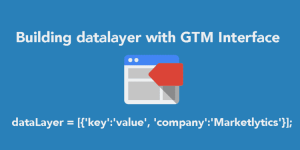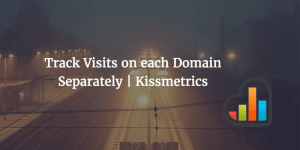Revenue attribution is the process of assigning credit for conversions and revenue to the various marketing channels and touchpoints that contribute to a sale. You can use it to determine which marketing activities are the most effective at driving sales and how different marketing channels work together to generate revenue.
In our previous articles, we talked about revenue attribution models, revenue attribution tools, how to do ad revenue attribution the right way, and how I, as a data consultant, can help you get the most out of the revenue attribution process.
This time, I’ll gather all that information in one place to make it easier for you to understand the complete process.
So, this article will cover:
- Five questions you need to ask yourself before acquiring data
- The benefits of revenue attribution
- Revenue attribution models
- How can I help you acquire data the right way
Five questions to ask yourself before acquiring data
As I stated, revenue attribution helps you connect purchases with exact activities and touchpoints inside your campaigns. There are five primary questions to ask yourself before acquiring data:
- What was a lead’s original and final touchpoint?
- What was their journey in between?
- Which campaign had the most success?
- Which ad copy proved to be the best?
- What keyword is the most beneficial?
Since revenue attribution is not easy, marketers often face challenges while answering these questions. I thoroughly explained these common challenges and the solutions to each of them. Read carefully.
Revenue attribution benefits
There are plenty of reasons why revenue attribution is of immense importance. I’ll mention only a few essential ones.
Leads prioritization
It’s crucial to be 100% certain from where a vast majority of your leads come from. And, of course, it varies in different niches.
The ecommerce store will probably benefit the most from Facebook or Instagram, while leads for a SaaS tool usually convert the most from LinkedIn.
So, the point is to understand which platform gives you the most leads/conversions and then prioritize your efforts based on that.
Better cooperation between marketing and sales teams
As a marketer, you can pass valuable information about revenue attribution to your sales team.
For example, you can inform them about which keywords (pain points) are the most successful so that they can construct their sales pitches around these keywords.
It could help them understand the target audience better, get a better approach to the conversation, change their pitch accordingly, and, as a result, close more deals.
Accurate monthly reports
There’s no way to convince your client or C-level executive that you’re doing a good job other than by showing them your exact results. They have to know if their expenses are worth it.
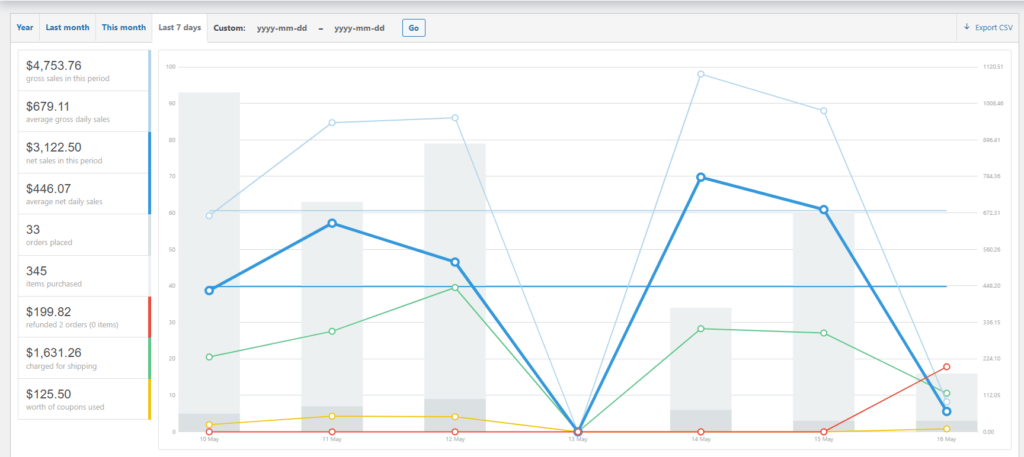
By measuring the profitability of each campaign for a few months, you’ll have a clear picture of what works and what does not. In other words, an accurate attribution process will show which channels and campaigns contribute the most to the revenue.
Revenue attribution models
Numerous revenue attribution models depend on specific business goals and objectives.
In one of our previous articles, I thoroughly analyzed these models. Now, I’ll mention only specific use cases for each of them.
There are two groups of revenue attribution models – single-touch and multi-touch. Single-touch models credit one part of the journey, while multi-touch models, as the name suggests, consider multiple channels.
Single-touch models

1. The first interaction model
Since this model gives all the credit to the first touchpoint, it’s most useful for early-stage businesses in campaigns created for the initial awareness.
2. The last interaction model
The situation is the opposite here – the whole credit goes to the last touchpoint. Therefore, it’s beneficial for short buying cycles without too many touchpoints before converting.
3. The last non-direct click model
Eliminating direct traffic is suitable when you know it comes from conversions you already won on other channels. This model ignores all direct sessions and gives full credit to the last touchpoint the lead clicked through before converting.
4. The last Google ads click model
This model will show you which one closes the most conversions if you’re running multiple ads.
Multi-touch models
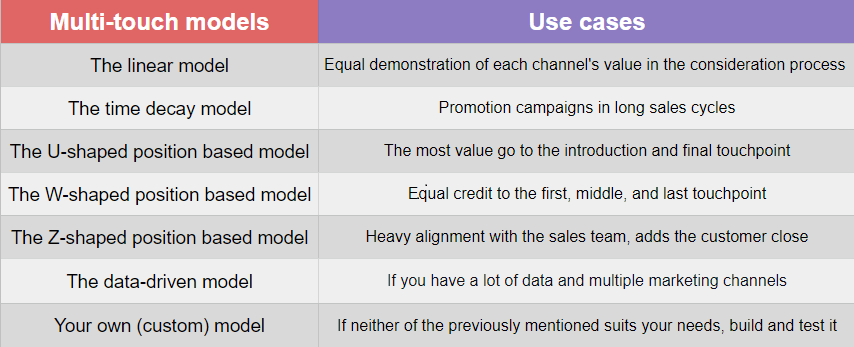
1. The linear model
The linear model is the simplest – evenly applying the credit to every touchpoint. This is the model for you if you want to demonstrate each channel’s value equally.
2. The time decay model
This model is slightly different since you give more credit to the touchpoint closer to the purchase moment. So, it’s helpful in long sales cycles.
3. The position-based model
It’s a hybrid of the first and last interaction models. You split the credit between these touchpoints based on your priorities.
This model has three variations: U-shaped, W-shaped, and Z-shaped. Learn more about them in this post.
4. The data-driven model
Simply get data from a computer and make decisions based on more machine learning. You can consider a data-driven model if you have a lot of data, for example, 30000 sales per year and more than six marketing channels.
5. Your own (custom) model
If you want to use different criteria to determine what things are most important to your sales cycles, then feel free to build your own model and test it. It is worth mentioning that going for the most complex option is not always the best idea, and the decision should be based on the business goals and requirements.
How can I help you do the revenue attribution the right way?
Even though you can do the revenue attribution on your own, it’s still not an easy thing to do. It’s easy to get confused with the information from Analytics, especially if some of the results don’t match your real sales numbers.
You’ll likely need expert help to correctly collect data about your most valuable campaigns and traffic sources. On top of that, I do it with security and privacy in mind to ensure that the data is only available to you.
Based on data, experts like us can help you:
- Build the suitable attribution models
- Get valuable insights on what are the most important focus points for your attribution
- Learn why you should give more priority to a particular channel or why one campaign is more critical than others
- Address gaps in customer journeys
- Evaluate potential problems and opportunities
- Follow protocols for processing confidential data
- Create reports, data visualizations, and dashboards
- Get technical expertise on how to store your data
- And much, much more
Besides these duties that are related to revenue attribution, there are plenty of other benefits you can get by hiring a data analytics consultant. You can learn more about my professional duties in this post.

Final verdict
So, what is the most important thing for you to draw out from this article?
- Ask yourself five questions (listed above) before collecting data.
- There are plenty of benefits that prove why revenue attribution is essential for businesses.
- There are single-touch and multi-touch models. Pick the one that suits your business and test it. Maybe, you can consider creating your own.
Revenue attribution is not easy. If you need some help, don’t hesitate to contact us.





